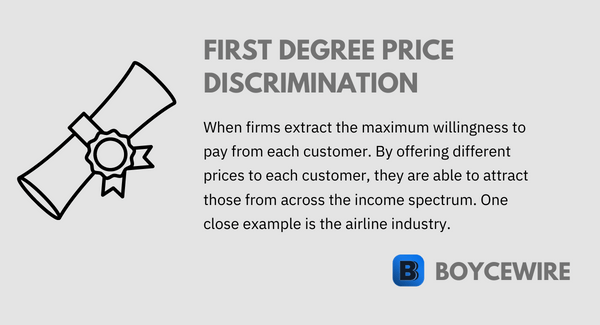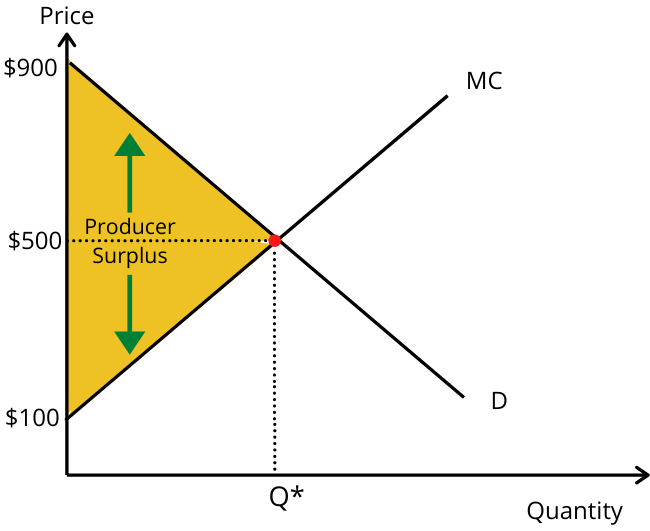First Degree Price Discrimination: Definition & Examples

What is First Degree Price Discrimination
First-degree price discrimination is where a business charges each customer the maximum they are willing to pay. This price can vary from customer to customer as the business charges the very maximum in order for the customer to purchase their goods. As a result, the firm is able to capture all consumer surplus and keep this as economic profit instead.
This is often a useful pricing strategy for businesses with high levels of fixed costs. For example, telecoms and utility firms often charge higher prices to customers who do not review their contracts. Often, after a year or two, such firms increase the price to a higher ‘variable rate’. Only when more price-sensitive customers get in contact do they offer lower rates which are more acceptable.
Those who do not choose to call up and renew at a lower fixed rate, end up paying a higher price. Whilst those who are unhappy with their fees end up calling in order to get a lower price. So the firm is able to extract a higher fee from those who are happy to pay, whilst also getting custom from those who want a lower price.
This works well for firms with high fixed costs because the cost to provide a service to an additional customer is almost non-existent. The infrastructure and high-level costs will still be payable whether that customer goes with that firm or another. So by offering a lower price, they are able to extract the maximum profit from each customer based on their willingness to pay.
Key Points
- First degree price discrimination is where a firm charges the customer their maximum willingness to pay.
- This is highly effective within firms with high fixed costs who are able to greatly reduce the price for price-sensitive consumers.
- Whilst first-degree price discrimination does not occur in the real-world, some close examples include airline tickets, utilities, and business to business services.
As with other forms of price discrimination, it can only be adopted when the market meets two main criteria:
- Ability to segment the market.
- Prevent re-sale.
First of all, the firm must be able to prevent a customer who is able to obtain a lower price, from selling it to another at a higher price. With reference to first degree price discrimination, firms are usually able to do this through licensing and ID requirements. For instance, a business that sells software to another may have restrictions on the number of employees who can use that service. This prevents the firm from then selling on the same software to other firms.
Second of all, the firm must be able to segment the market. That means the firm is easily able to identify the maximum each customer is willing to pay and thereby extract that from each customer. For example, younger adults may be willing to pay more for video games than older adults. This may be done through income, time of the week, or age – among others.
First-Degree Price Discrimination in the real-world
First-degree price discrimination is more of a theoretical concept than a reality. It is something for businesses to aim towards than their actual ability to achieve. After all, being able to charge each customer the absolute maximum they are willing to pay is near on impossible.
Some firms are able to implement some form of specific pricing strategy – for example, coupons – which verges on first-degree price discrimination. Whilst firms will be unable to charge the absolute maximum, they will be able to charge different values which vary depending on their willingness to pay.
Traditionally, sellers would try and maximise their sales through individual observation and negotiation. For example, when most trade was done via markets, sellers would make assumptions based on an individual’s age, gender, and attire – anything that would signal the consumer’s willingness and ability to spend. Often, negotiations would depend on these initial assumptions. For example, individuals who are well-dressed are more likely to be charged higher prices based on their assumed ability and willingness to pay.
The issue with this age-old approach is that it is a time-consuming and a flawed process. Not every individual in a suit is rich, nor is everyone in a tracksuit poor. On top of this, it is a very inefficient method, particularly for big companies that sell millions of goods. It would be impossible to do this for each customer and for each item they buy.
First Degree Price Discrimination Graph
When a firm practices first-degree price discrimination, it consumes all the consumer surplus. In normal market conditions, consumers would pay a price which is usually less than they would otherwise be willing to pay. The difference between what they are willing to pay and what they actually pay is known as the consumer surplus.
So in price discrimination, there is no consumer surplus as each consumer pays the maximum they are willing to. This means that the consumer surplus now belongs to the producer and is shown in the form of profits.
The graph below demonstrates this relationship between the businesses and their consumers. For example, at $900, demand is equal to zero, but starts to increase along the demand curve. It demonstrates the relationship in the entire market as a whole, as opposed to that of an individual customer. So at $800, demand starts to increase. This might mean that 100 customers are willing to pay this price, whilst the marginal cost for these is around $300 – which would mean the producer surplus for these is $500.

The price gradually increases, accounting for more and more producer surplus as we go down the demand curve and reach the equilibrium point at $500. It is important to note that after this point, the price consumers would be willing to pay is less than it would cost to produce more goods – which is why the firm stops production at this point.
Across the market, there are thousands and millions of consumers that are purchasing all at different prices between $900 and $500. For each consumer, the firm makes a profit, known as the producer surplus. It will vary from consumer to consumer, depending on how much they paid.
First Degree Price Discrimination Examples

In the real world, first-degree price discrimination doesn’t exist as it is just too expensive and difficult to specifically obtain each consumer’s maximum willingness to pay. Not only is it difficult to find out, but it is practically impossible to do. There is also the element of each individual’s cognitive ability. The maximum price they are willing to pay can fluctuate rapidly. For instance, when a consumer is looking through the store, they may find something they like, but when they see something they prefer, they put the first good back as this has changed their valuation.
Instead of being a real-life model, first-degree price discrimination is more of a theoretical benchmark to aim towards. Firms do try and achieve first-degree price discrimination, but not to the extent whereby they are able to capture the full consumer surplus. They may in fact be able to charge different prices to each consumer, but may not be able to charge the exact maximum they would be willing to pay.
Although first-degree price discrimination does not exist in its entirety, there are a few examples whereby firms are able to price discriminate on an individual basis. However, due to the difficulty of approximating an individual’s maximum willingness to pay, they are not able to extract the full consumer surplus from the customer.
Airlines
Most airlines operate a form of price discrimination by using dynamic pricing. This is simply where prices fluctuate depending on current demand. For instance, if tickets are selling quickly, then prices will start to rise. If tickets are hardly selling, then the prices may fall to attract more customers.
Whilst this form of price discrimination doesn’t necessarily maximize revenue from the consumer, it does increase the firm’s profits by taking advantage of some consumer’s higher willingness to pay. For example, those consumers who are price-sensitive are more likely to book when the tickets come out and are at their cheapest. By contrast, those who are not so sensitive to prices may book last minute when prices may be significantly higher.
Therefore, airlines are able to segment between more price-sensitive consumers and those who are not. For instance, those who need to travel for last-minute business will have a higher willingness to pay than a family of four looking for a holiday.
Business to Business Services
It is much easier to use price discrimination in the service industry as the firm has more control over who can access these – as opposed to physical goods that can be resold. This is why businesses are freely able to use price discrimination to sell between different clients. Not every business has the same budget for the goods they are selling.
For instance, a big firm like Walmart will have a far bigger budget than a small firm such as Barry’s Bicycles. So the willingness to pay is going to differ dramatically between businesses.
Some firms will offer different packages based on the size of the organization. For instance, if a company requires 100+ users, then they will pay a higher fee than those who only need 5 users. Even though the set-up cost is the same, they are able to charge different prices in order to attract custom from each business which has different budget constraints.
Utilities
Utility firms usually offer fixed-term contracts over a year or two by which the consumer is offered a lower rate. However, once this term expires, consumers are put onto a higher variable rate. Yet a significant number of consumers will remain on this variable rate, paying a higher fee each month.
More price-sensitive consumers will get in contact and either switch providers, or move onto a cheaper tariff. By contrast, those consumers who are less price-sensitive may stay with the same utility provider and variable rate, thereby paying a higher fee for the same service.
FAQs
First degree price discrimination is where a firm sells for the maximum price the consumer is willing to pay.
In order to calculate the profit in first-degree price discrimination, it is important to find where marginal costs meet demand. At this point, the firm will no longer produce any further goods, which will show total profits. This is then calculated by finding the area between the demand and marginal cost curves.
First-degree price discrimination is more of a theoretical concept than a reality. This is mainly due to the fact that it is almost impossible to work out each individual consumers willingness to pay. However, airlines are a relatively good example as they alter prices depending on how many consumers are looking at its flights and how many are purchasing them.
About Paul
Paul Boyce is an economics editor with over 10 years experience in the industry. Currently working as a consultant within the financial services sector, Paul is the CEO and chief editor of BoyceWire. He has written publications for FEE, the Mises Institute, and many others.

Further Reading
 Giffen Good - A Giffen good is an unusual type of inferior good in which an increase in price leads to an increase…
Giffen Good - A Giffen good is an unusual type of inferior good in which an increase in price leads to an increase…  Corporate Social Responsibility (CSR): Definition & Examples - Corporate Social Responsibility (CSR) is a type of corporate strategy that looks at how the business can better society as…
Corporate Social Responsibility (CSR): Definition & Examples - Corporate Social Responsibility (CSR) is a type of corporate strategy that looks at how the business can better society as… 